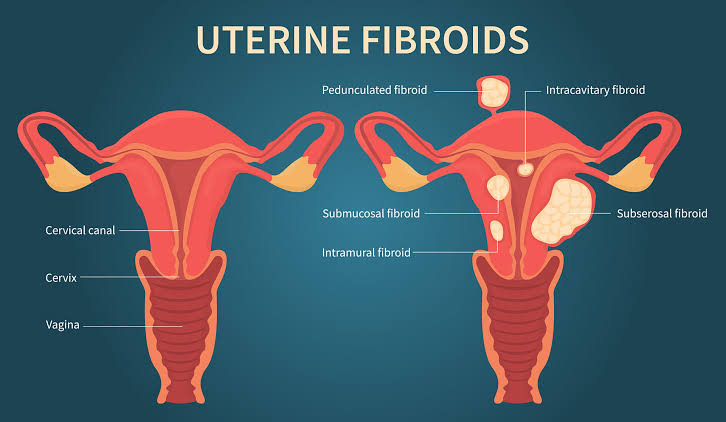Sandeep Dhand
Nutritionist And Health Educator
Uterine fibroids, also called leiomyomas or myomas, are non-cancerous growths that develop in or around the uterus. They are made of muscle and fibrous tissue and can vary in size, shape, and location. Some fibroids are as small as a pea, while others can grow as large as a melon. In many cases, fibroids do not cause any symptoms and are only discovered during routine medical exams. However, in some women, fibroids can lead to noticeable and uncomfortable symptoms that require treatment.

Types of Uterine Fibroids
There are four main types of uterine fibroids based on their location:
- Intramural Fibroids:
These grow within the muscular wall of the uterus. They are the most common type and can cause symptoms like heavy periods and pelvic pain. - Submucosal Fibroids:
These develop under the inner lining of the uterus and can grow into the uterine cavity. They often lead to heavy menstrual bleeding and can sometimes interfere with fertility. - Subserosal Fibroids:
These grow on the outer surface of the uterus and can sometimes press on nearby organs like the bladder or rectum, causing pressure or discomfort. - Pedunculated Fibroids:
These are fibroids that grow on a stalk, either inside or outside the uterus. Depending on their size and location, they can cause pain or other issues.
Who Gets Uterine Fibroids?
Fibroids are very common, especially in women of reproductive age (20–50 years). Researchers are not exactly sure why fibroids develop, but several factors may increase the likelihood of getting them:
- Hormones:
Estrogen and progesterone, the hormones that regulate the menstrual cycle, play a role in fibroid growth. - Genetics:
If your mother or sister had fibroids, you’re more likely to develop them too. - Age:
Fibroids are more common as women age, particularly in their 30s and 40s. - Lifestyle Factors:
Obesity, lack of physical activity, and a diet high in red meat and low in green vegetables may increase the risk. - Ethnicity:
Fibroids are more common and tend to be larger and more numerous in Black women compared to women of other ethnicities.
Symptoms of Uterine Fibroids
Some women with fibroids have no symptoms at all, while others experience severe symptoms that affect their daily life. Common symptoms include:
Heavy or Prolonged Periods: Fibroids can cause heavy menstrual bleeding, sometimes with clots.
Pelvic Pain or Pressure: Larger fibroids can press on surrounding organs, causing pain or a feeling of fullness in the abdomen.
Frequent Urination: Fibroids pressing on the bladder can make you feel like you need to urinate more often.
Constipation: If a fibroid presses on the rectum, it can cause bowel issues.
Pain During Intercourse: Some fibroids, depending on their location, can make sexual activity uncomfortable or painful.
Difficulty Getting Pregnant: Submucosal fibroids, in particular, can interfere with the implantation of an embryo, making it harder to conceive.
Diagnosis of Uterine Fibroids
If your doctor suspects you have fibroids based on your symptoms, they may perform one or more of the following tests:
- Pelvic Exam:
A manual examination of the uterus to check for irregularities in size or shape. - Ultrasound:
This imaging test uses sound waves to create a picture of the uterus and identify fibroids. - MRI:
In some cases, an MRI may be used to get a more detailed view of the size and location of fibroids. - Hysteroscopy:
A small camera is inserted into the uterus through the vagina to examine the uterine cavity and detect submucosal fibroids.
Treatment Options for Uterine Fibroids
The treatment for fibroids depends on several factors, including the size and location of the fibroids, your symptoms, and whether you plan to have children. Here are some common treatment options:
- Medications:
Hormonal birth control (pills, patches, or IUDs) to regulate periods and reduce bleeding.
Gonadotropin-releasing hormone (GnRH) agonists to shrink fibroids temporarily.
Over-the-counter pain relievers like ibuprofen to manage symptoms.
- Minimally Invasive Procedures:
Uterine Artery Embolization (UAE): This procedure blocks blood flow to fibroids, causing them to shrink.

MRI-Guided Focused Ultrasound: A non-invasive procedure that uses ultrasound waves to destroy fibroid tissue.
- Surgical Options:
Myomectomy: Removes fibroids while preserving the uterus, ideal for women who wish to have children.
Hysterectomy: Complete removal of the uterus, a permanent solution for fibroids.
- Lifestyle Changes:
Maintaining a healthy weight, eating a balanced diet, and exercising regularly can help manage symptoms.
Can Fibroids Be Prevented?
While you can’t completely prevent fibroids, certain lifestyle changes may lower your risk:
Eating more fruits, vegetables, and whole grains.
Reducing red meat and processed food intake.
Staying physically active.
Managing stress levels.
When Should You See a Doctor?
If you experience symptoms like heavy bleeding, severe pelvic pain, or difficulty with urination or bowel movements, it’s essential to consult a doctor. Early diagnosis can help manage fibroids effectively and prevent complications like anemia or infertility.
Conclusion
Uterine fibroids are a common but manageable condition. While they are rarely life-threatening, they can significantly impact a woman’s quality of life. With the right treatment and lifestyle adjustments, most women with fibroids can lead healthy and active lives. If you suspect you have fibroids, don’t hesitate to seek medical advice and explore your options.